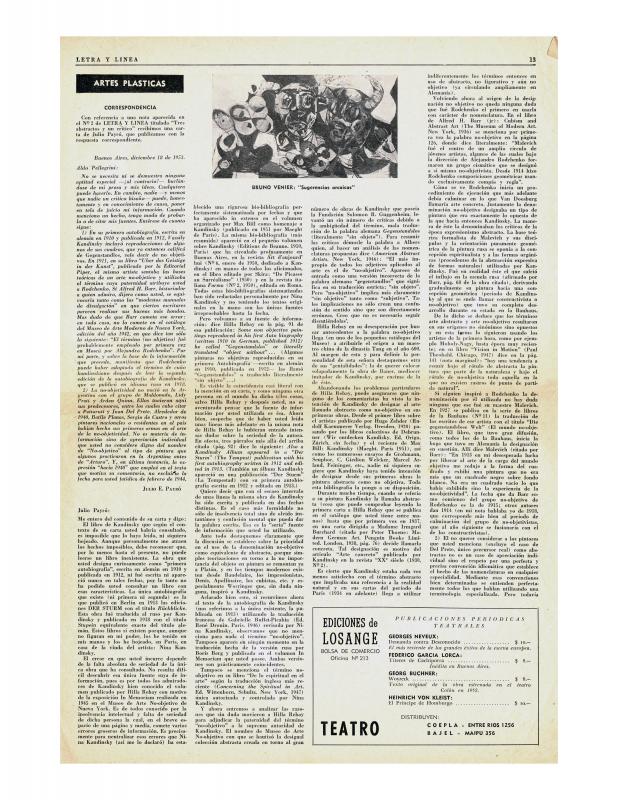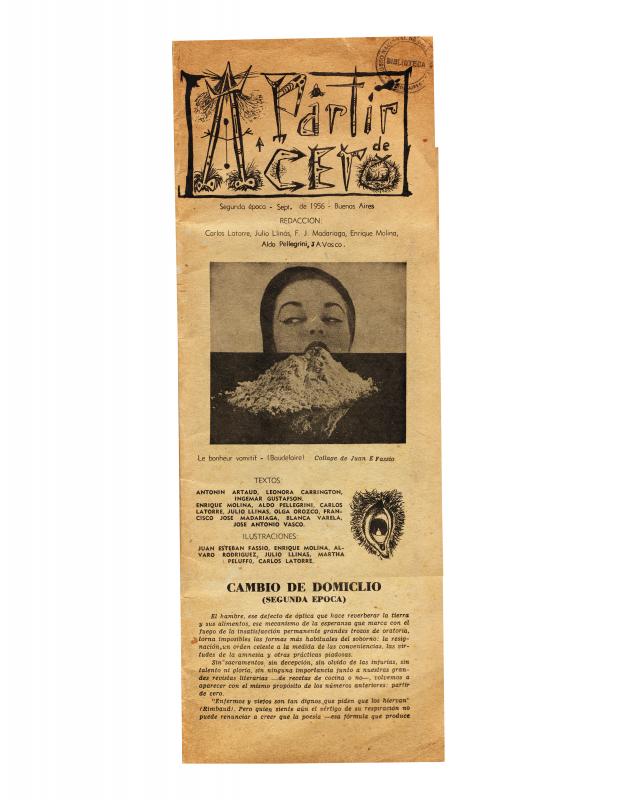Aldo Pellegrini (Rosario, 1903–Buenos Aires, 1973) was an outstanding poet, playwright, essayist, and art critic in the cultural milieu of Argentina. Linked from its first moment with the development of Surrealism, he directed several editorial projects. Pellegrini also supported and helped spread the different aspects of Abstract art, launching several groups, such as Artistas Modernos de la Argentina [Modern Artists of Argentina] and the Asociación Arte Nuevo [New Art Association]. Letra y Línea. Revista de cultura contemporánea. Artes plásticas. Literatura. Teatro. Cine. Música. Crítica. [Letter and Line. A Contemporary Culture Journal. Plastic Arts. Literature. Drama. Music. Critique.]It was a contemporary culture publication directed by Aldo Pellegrini that published four editions between October 1953, and July 1954. The journal had several collaborators, including Edgar Bayley (1919–90), Osvaldo Svanascini (1920), Oliverio Girondo (1890–1967), Mario Trejo (1926), Enrique Molina (1910–97), Juan Carlos Paz (1897–1972), and Norah Lange (1906–72), among others. Oliverio Girondo was an Argentinean poet married to poet Norah Lange, linked to many martinfierristas [writers who wrote for the Martin Fierro journal], such as Jorge Luis Borges (1899–1986), Raúl González Tuñón (1905–74), Macedonio Fernández (1874–1952), Ricardo Güiraldes (1886–1926), and Leopoldo Marechal (1900–70), among many others. During the 1930s, Girondo maintained an intense participation in the country’s public literary life and later, due to the experimental character of his poems published in the book En la masmédula [In the deepest core] (1954), he became very influential over the generation of poets who were connected to Pellegrini and the journal Letra y Línea. Julio E. Payró’s (1899–1971) letter disputes Pellegrini’s critique that appeared in the number 2 edition of Letra y Línea journal regarding the works of Armando Coppola, Hortensia Tarazi, and María Deprima, in which Pellegrini insisted that in its “prologuito” [little prologue], Payró insisted on stating that Wassily Kandinsky had originated the non-objective term (See document no. 745469). These arguments continued in the journal Buenos Aires Literaria [Buenos Aires Literary] (directed by Andrés Ramón Vázquez and published between 1952–54) , starting with a short story titled “De aporte positivo” [About a Positive Contribution], which Borges and Adolfo Bioy Casares submitted under the pseudonym Bustos Domecq. Likewise, an article called “Borges y Bioy Casares, paladines de la literatura gelatinosa” [Borges and Bioy-Casares, Paladins of Gelatinous Literature], was published in the last edition of Letra y Línea, and “Comentarios a tres frases de autores célebres” [Comments in Three Phrases by Famous Authors] (see document no.744705) was linked to the short story. The second article was published in September 1, 1956, in the journal A partir de cero [Starting from Zero], which circulated from 1952 and initiated a second phase in 1956, directed by poet Enrique Molina. This source has been selected because it helps to reconstruct the debates generated upon the emergence of Abstract art in Argentina, allowing us to follow Aldo Pellegrini’s actions and incisive insight throughout an ample network of exchanges.


